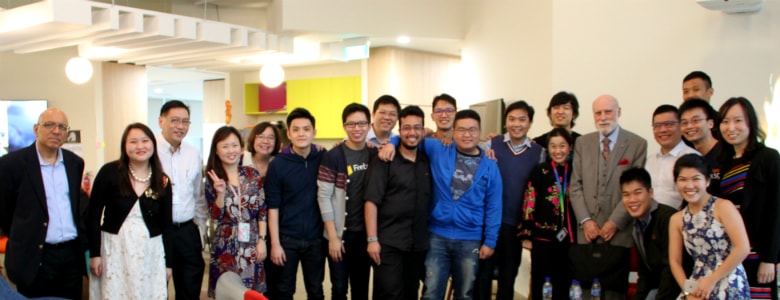Of Aliens and the Digital Dark Age

It may be hard to remember what life was like before mankind went online en masse.
But the internet wasn’t handed to us on a silver platter; it was carefully designed by a group of people.
On 19 January 2017, the GovTech Hive played host to one of the ‘fathers of the internet’ — 2004 Turing award winner Dr Vinton Gray Cerf.
In 1973, Dr Cerf, working with fellow Turing Award winner Robert Kahn, developed the Transmission Control Protocol and Internet Protocol (TCP/IP), which allowed packets of information to be transmitted between computers on different networks, and which now form the basis of the modern-day internet.
So it was with great pleasure that we welcomed Dr Cerf, now Vice President and Chief Internet Evangelist at Google, to Hive.
He sat down with tech specialists and other members of the GovTech team for a fireside chat.
The wide-ranging discussion was moderated by Mr Chan Cheow Hoe, GovTech’s Deputy Chief Executive and Government Chief Information Officer.
Designing systems to last the Future
Dr Cerf has warned of a digital Dark Age — a future in which digital documents and images are lost forever as the hardware or software required to read them becomes obsolete.
“If you care about history, or even just passing along the story of your family, then you worry that this information won’t be available in the future,” he told the audience.
One measure to prevent this, Cerf said, might be to design a legal framework that gives archivists special access to source code—typically fiercely guarded by companies as intellectual property (IP)—so that they can reverse engineer ways to read old data.
There are also ongoing efforts to use virtual machines to emulate, or reproduce the function of, old hardware, so that legacy operating systems and applications can run, he said.
The Dark Age problem begets a bigger question: How do we then, design systems that will stay functional?
Posed this question by a member of the audience, Dr Cerf cited TCP/IP as an example of a technology that was designed with the long-term future in mind.
“We consciously tried to future-proof the basic transport of information packets from one place to another,” he said.
The system, he said, was designed to be “ignorant”—packets had no information about the medium through which they were being carried, whether it was radio link, satellite, or some unknown future communications technology.
They also did not know what data they were carrying, or what application they were supporting.
“Postcards don’t know how they’re being carried, and they also don’t know what’s written on them. Internet packets have the same lack of knowledge.”
Because of these design choices, the technology aged well, and could easily be adopted for new applications such as transmitting websites and video files.
“That was really important because if someone wants to build a new application, they wouldn’t have to go to every internet service provider in the world and say: ‘Please change the network to support my application,’” he explained.
The Non-human Internetz
Still, Dr Cerf added, it is impossible to future-proof against all scenarios, especially those that are quite literally out of this world.
More recently, he has been involved in building the interplanetary internet, which now extends between Earth, Mars and the International Space Station.
Because of the vast distances between planets (“We noticed that the speed of light was too slow,” he said) and disruptions caused by planetary rotation, TCP/IP could not be adapted for this purpose.
New protocols — called the bundle protocols — had to be developed to address the challenges associated with interplanetary communication, he said.
But vast distances exist — metaphorically, of course — even on Earth, where animal species communicate in such different ways that they might as well be from different planets.
“I think we should recognise that mammals have varying degrees of intelligence, but it is fair to say it’s intelligence. There’s real mental capacity there.”
Is it then possible for us to talk to animals, and for them to talk to each other, through an interspecies internet?
Dr Cerf and animal behavior experts are exploring new interfaces that might allow us to do just that.
Dolphins, for example, can be trained to use touchscreens to communicate with humans; software might then be used to translate this communication into the ‘language’ of other non-human species — sign language in the case of the great apes, for instance.
“Once we learn how to do that, if aliens ever show up, we’d be able to start communicating with them!”
A Beacon for the World
Asked for his thoughts on Singapore’s future in the digital economy, Dr Cerf said: “I’ve come away with the sense that Singapore is ready to do something new. There is a kind of search for the next big thing for the country to do.”
Singapore’s small size, he said, works in its favour, allowing it to roll out initiatives — in information technology, healthcare or other areas — across the entire nation.
“Getting to 100 percent is a big deal — most countries never get there,” he said.
“You can become a kind of beacon for the rest of the world to see what it would be like if they could do what Singapore has done.”
https://www.tech.gov.sg/media/technews/of-aliens-and-the-digital-dark-age
